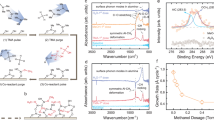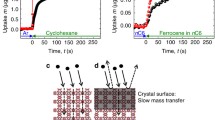Abstract
Ceramic membranes generally consist of permselective material as standalone disks or tubes or as thin films on porous supports. Applications are often energy/environment- related in H2, CO2 and O2 separation, H2O pervaporation, hydrocarbon separation/partial oxidation and liquid treatment such as water purification. Thin membrane films can be applied on porous supports by particulate, wet-chemical or vapor phase deposition techniques. Examples of permselective inorganic membrane compositions are dense Pd alloys and various perovskites, micro-porous (Ø < 2 nm) amorphous silica and zeolites and meso-porous (2 < Ø < 50 nm) alumina, silica and titania. The latter membranes may act as intermediate supporting layers for micro-porous membranes. Transport descriptions for meso- and macro-porous (Ø > 50 nm) membranes are based on the concepts of Knudsen diffusion (gases only), viscous flow or Maxwell-Stephan (MS) multi-component transport (Dusty Gas Model for gasses). Transport in dense membranes is described by Onsager irreversible thermodynamics and often worked out in terms of concentration- and/or field-driven diffusion. The transport descriptions as mentioned are near-equilibrium approaches that incorporate semi-empirical expressions for the chemical potential (μl) of transporting species, l. The limited definition of state-of-the-art membranes justifies the use of ideal gas thermodynamics for gases, empirical Davies μ l 's for ions in liquids and Langmuir thermodynamics for surface adsorption and for most mobile species in 3-D lattices. Mobile electrons in cobaltates and metals form an exception to the latter, being better described as a Fermi liquid correlated electron system. Onsager cross-terms are seldom considered and are likely to be most relevant for molecular diffusion in gas mixtures and mixed electron-ion conductors; in both cases when different species have a significant energetic interaction. Differences in mobility of charged species may lead to the development of diffusion fields that can be incorporated in the chemical potential of that species. Single- and multi-component diffusion in liquids and in micro-porous and dense membranes can be described with chemical-, field- or MS diffusion coefficients. In solid state transport these can be related to mechanical mobilities for vacancy or interstitial mechanisms. Non-equilibrium correlation effects in diffusion can generally be ignored, except for the case of multi-component diffusion of species on a host lattice at high concentrations and with large differences in mobilities. Attempts to increase fluxes with thinner membranes have resulted in support transport resistances becoming comparable to membrane resistances. Complete descriptions of multi-component transport in supported membrane structures generally requires a numerical treatment with increasing importance of multi-scale methods. Those descriptions are needed to design fully optimized membrane structures and processes. The supports can be made at a reasonable cost by conventional ceramic pressing and extrusion techniques. Modern colloidal consolidation techniques enable very homogenous structures for accurate transport measurements and design of optimized graded porosity structures. For practical applications more attention must be paid to membrane adhesion, surface functionalization (hydrophobicity), thermochemical stability, mechanical and dimensional properties and sealing.
Similar content being viewed by others
References
R. R. Bhave, “Inorganic membranes, Synthesis, Characteristics and Applications” (Van Nostrand Reinhold, New York, 1991).
H. Verweij, “Novel Synthesis of Ceramic Membranes,” in Proc. 10th Int. Ceramics Congres & 3rd Forum on NewMaterials, Session J-4, Florence, Italy, July 14–18, 2002.
L. M. van der Haar, “Mixed-conducting perovskite membranes for oxygen separation—Towards the development of a supported thin film membrane,” Thesis, University of Twente, Enschede, The Netherlands 2001.
Y. S. Lin and A. J. Burggraaf J. Membrane Sci. 79(1) (1993) 65.
A. Nijmeijer H. Kruidhof R. Bredesen and H. Verweij J. Amer. Ceram. Soc. 84(1) (2001) 136.
R. M. de Vos and H. Verweij Science 279 (1998) 1710.
Y. Lu G. Cao R. P. Kale S. Prabakar G. P. Lopez and C. J. Brinker Chem. Mater. 11 (1999) 1223.
H. Verweij G. de With and D. Veeneman J. Mater. Sci. 20(3) (1985) 1069.
C. J. M. van Rijn W. Nijdam S. Kuiper G. J. Veldhuis H. A. G. M. van Wolferen and M. C. Elwenspoek J. Micromech. Microengin. 9(2) (1999) 170.
F. C. M. Woudenberg W. F. C. Sager N. G. M. Sibelt and H. Verweij Adv. Mater. 13(7) (2001) 514.
J. Reyes-Gasga T. Krekels G. van Tendeloo J. van Landuyt W. H. M. Bruggink H. Verweij and S. Amelinckx Sol. St. Comm. 70(4) (1989) 269.
C. S. Chen H. Kruidhof H. J. M. Bouwmeester H. Verweij and A. J. Burggraaf Solid State Ionics 86/88(1) (1996) 569.
For IZA zeolite structure acronyms see: http://www.iza-structure. org/databases/.
Z. P. Lai G. Bonilla I. Diaz J. G. Nery K. Sujaoti A. M. Amat E. Kokkoli O. Terasaki R. W. Thompson M. Tsapatsis and D. G. Vlachos Science 300(5618) (2003) 456.
Y. F. Lu R. Ganguli C. A. Drewien M. T. Anderson C. J. Brinker W. L. Gong Y. X. Guo H. Soyez B. Dunn M. H. Huang and J. I. Zink Nature 389(6649) (1997) 364.
D. Zhao P. Yang N. Melosh J. Feng B. F. Chmelka and G. D. Stucky Adv. Mater. 10(16) (1998) 1380.
C. Y. Tsai S. Y. Tam Y. F. Lu and C. J. Brinker J. Membrane Sci. 169(2) (2000) 255.
H. Xu and W. A. Goedel Langmuir 18(6) (2002) 2363.
P. M. Biesheuvel V. Breedveld A. P. Higler and H. Verweij Chem. Eng. Sci. 56(11) (2001) 3517.
J. E. Smay J. Cesarano and J. A. Lewis Langmuir 18(14) (2002) 5429.
X. Han K. W. Koelling D. L. Tomasko and L. J. Lee Polym. Eng. Sci. 42(11) (2002) 2094.
M. H. R. Lankhorst H. J. M. Bouwmeester and H. Verweij J. Amer. Ceram. Soc. 80(9) (1997) 2175.
N. Benes and H. Verweij Langmuir 15(23) (1999) 8292.
N. E. Benes H. J. M. Bouwmeester and H. Verweij Chem. Eng. Sci. 57(14) (2002) 2673.
N. E. Benes G. Spijksma H. Verweij H. Wormeester and B. Poelsema AIChE J. 47(5) (2001) 1212.
N. E. Benes, Mass Transport in Thin Supported Silica Membranes, Thesis, University of Twente, Enschede, The Netherlands, 2001.
M. H. R. Lankhorst H. J. M. Bouwmeester and H. Verweij Phys. Rev. Lett. 77(14) (1996) 2989.
W. Schottky, “Halbleiterprobleme,” Vol. IV, 235 (1958).
C. W. Davies, “Ion Association” (Butterworths, London, 1962) p. 41.
R. M. de Vos and H. Verweij J. Membrane Sci. 143(1) (1998) 37.
H. Verweij W. H. M. Bruggink R. A. Steeman E. Frikkee and R. B. Helmholdt Physica C 166(4) (1990) 372.
P. M. Biesheuvel Langmuir 17(12) (2001) 3553.
W. B. S. de Lint, Transport of Electrolytes through Ceramic Nanofiltration Membranes, Thesis, University of Twente, Enschede, The Netherlands, 1997.
M. H. R. Lankhorst, Thermodynamic and transport properties of mixed ionic-electronic conducting perovskite oxides, Thesis, University of Twente, Enschede, The Netherlands, 1997.
P. M. Biesheuvel and H. Verweij J. Membrane Sci. 156 (1999) 141.
Author information
Authors and Affiliations
Rights and permissions
About this article
Cite this article
Verweij, H. Ceramic membranes: Morphology and transport. Journal of Materials Science 38, 4677–4695 (2003). https://doi.org/10.1023/A:1027410616041
Issue Date:
DOI: https://doi.org/10.1023/A:1027410616041




